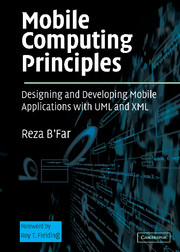Book contents
- Frontmatter
- Contents
- Foreword by Roy T. Fielding
- Acknowledgments
- SECTION 1 INTRODUCTIONS TO THE MAIN TOPICS
- SECTION 2 DEVICE-INDEPENDENT AND MULTICHANNEL USER INTERFACE DEVELOPMENT USING UML
- SECTION 3 ADDITIONAL DIMENSIONS OF MOBILE APPLICATION DEVELOPMENT
- Chapter 9 Mobile Agents and Peer-to-Peer Architectures for Mobile Applications
- Chapter 10 Wireless Connectivity and Mobile Applications
- Chapter 11 Synchronization and Replication of Mobile Data
- Chapter 12 Mobility and Location-Based Services
- Chapter 13 Active Transactions
- Chapter 14 Mobile Security
- SECTION 4 PUTTING THE PROJECT TOGETHER
- References
- Index
Chapter 10 - Wireless Connectivity and Mobile Applications
from SECTION 3 - ADDITIONAL DIMENSIONS OF MOBILE APPLICATION DEVELOPMENT
Published online by Cambridge University Press: 03 September 2009
- Frontmatter
- Contents
- Foreword by Roy T. Fielding
- Acknowledgments
- SECTION 1 INTRODUCTIONS TO THE MAIN TOPICS
- SECTION 2 DEVICE-INDEPENDENT AND MULTICHANNEL USER INTERFACE DEVELOPMENT USING UML
- SECTION 3 ADDITIONAL DIMENSIONS OF MOBILE APPLICATION DEVELOPMENT
- Chapter 9 Mobile Agents and Peer-to-Peer Architectures for Mobile Applications
- Chapter 10 Wireless Connectivity and Mobile Applications
- Chapter 11 Synchronization and Replication of Mobile Data
- Chapter 12 Mobility and Location-Based Services
- Chapter 13 Active Transactions
- Chapter 14 Mobile Security
- SECTION 4 PUTTING THE PROJECT TOGETHER
- References
- Index
Summary
The transparency of thought in existence is inwardness.
Søren KierkegaardINTRODUCTION
One of the first topics that we discussed in this text was the definition of mobility and how it differs from wireless connectivity. By definition wireless connectivity between a mobile device and another device requires a physical layer networking technology. To cover all of the subjects that will allow one to comprehensively understand wireless connectivity and its currently existing permutations is impossible, not just in this text, but even in a dedicated text. One may require an entire library to gather all of the various topics on wireless connectivity and related inventions. So, the first thing that we might do is to reduce the scope of what wireless connectivity may mean in our discussion of mobile computing.
In this chapter, we will first look at a basic introduction to wireless communication that will include examples of techniques and technologies from the various abstraction layers in wireless communications.
We can qualify two types of connectivity to the network: strong and weak. We use the concept of strong and weak connections in various places in this text. Essentially, a weak connection refers to lower QOS than strong connectivity but higher than disconnection. This way of distinguishing weak and strong connections is fairly subjective and relative to the application. Unfortunately, because of the changing landscape of communication and computing, we cannot quantify the QOS properties of strong and weak connectivity.
- Type
- Chapter
- Information
- Mobile Computing PrinciplesDesigning and Developing Mobile Applications with UML and XML, pp. 615 - 651Publisher: Cambridge University PressPrint publication year: 2004



